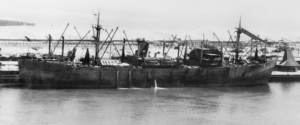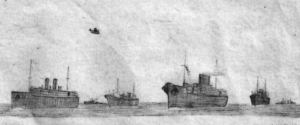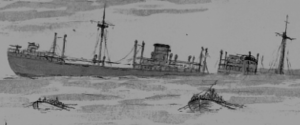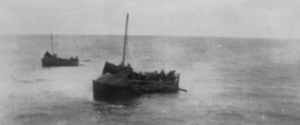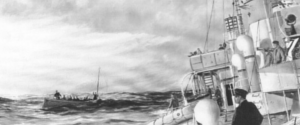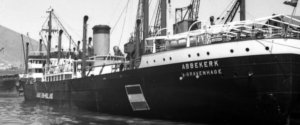Abbekerk’s aftermath: The Battle of the Atlantic

The fall and winter of 1942 were the low point of the battle measured by the number of merchant ships sunk. But it also marked a change, although not recognized at the time. During the spring of 1943 the Allied forces gained the advantage and at a certain point in time Germany even recalled all U boats back to France because of the severe losses. Most important factors of that change were the development of radar, which by this time even fitted in planes. Making the U boats visible in the dark, fog and bad weather. The radio direction finder was very important and also the fact that the Allied forces had broken the German codes.
 Actually it was the German stubbornness in their denial of the possibility of a broken code, radar fitting in planes and radio transmissions giving away location that prevented them to act timely. They also kept too long, to the mass production and old design of their U boats and made little innovations. The Allied forces on the other hand were innovative in techniques as well as in tactics. The entering of the war by the Americans gave them increasingly more ships and planes available to fight against the U boats. Special hunter-killer groups were formed comprising of aircraft carriers and destroyers which were sent to locations where U boats were suspected to be or to convoys under serious attack.
Actually it was the German stubbornness in their denial of the possibility of a broken code, radar fitting in planes and radio transmissions giving away location that prevented them to act timely. They also kept too long, to the mass production and old design of their U boats and made little innovations. The Allied forces on the other hand were innovative in techniques as well as in tactics. The entering of the war by the Americans gave them increasingly more ships and planes available to fight against the U boats. Special hunter-killer groups were formed comprising of aircraft carriers and destroyers which were sent to locations where U boats were suspected to be or to convoys under serious attack.
There was no place or time left on the oceans for a submarine to hide.

Homeward bound, a Liberty Ship in convoy RA64 sails through heavy seas in the Arctic Ocean.
(Source: ADMIRALTY OFFICIAL COLLECTION)
Furthermore the American industry built standard ships (liberty vessels) at an amazing pace. In 1943 it took an average of 43 days to build a ship and every day 3 (!) were launched. Making it impossible for the Germans to win the ‘tonnage war’. And as the Atlantic became safer for ships to cross, the build up of troops and materials in England to make the invasion of Europe possible could start.
Starting the summer of 1943 the U boat had lost it’s power. But they were still deployed, in large numbers till the end of the war. Not to achieve a definitive victory but only to keep the enemy and as much materials as possible busy to try and prevent an invasion. They still inflicted significant damage to allied shipping but the costs were huge. Of the 750 U boats in the Atlantic more than 500 were sunk. Killing 18000 out of 27000 crew ( 3 in 4) .

The story of the sailors of the merchant Navy during the war has always had much more publicity in the UK than in The Netherlands
The price paid by the merchant navy is similarly unimaginable. During the whole war, on the Atlantic ocean alone, more than 2200 ships were sunk. 36.000 crew killed. The navy and air force also lost hundreds of ships and planes and thousands of troops. The large merchant navy fleets of England and the USA took the biggest losses but also the – not really small- fleets of Norway, Greece and the Netherlands were decimated. The Netherlands lost 360 of the it’s 541 sea going vessels, with the lives of 3600 crew.
The Battle of the Atlantic lasted from the first till the last day of the war which makes it the longest during battle of the entire war.
 The role of the merchant navy and it’s civilian crews is a very underexposed chapter of world war II, especially in Holland. I hope that this website, on the history of Abbekerk and it’s crew, will ensure that we will never forget what these men went through and did for the liberation of the world. The Dutch merchant navy ship was one of the very few places the Dutch flag waved proudly throughout the war.
The role of the merchant navy and it’s civilian crews is a very underexposed chapter of world war II, especially in Holland. I hope that this website, on the history of Abbekerk and it’s crew, will ensure that we will never forget what these men went through and did for the liberation of the world. The Dutch merchant navy ship was one of the very few places the Dutch flag waved proudly throughout the war.
Losses in numbers:
| Allies | Germans |
|---|---|
| 36,200 sailors | 30,000 sailors |
| 3,500 merchant vessels | 783 submarines |
| 175 warships |
Allied merchant navy losses in all oceans
| Location | Number of British, Allied, neutral ships | Total Gross Registered Tonnage |
|---|---|---|
| North Atlantic | 2,232 | 11,900,000 tons |
| South Atlantic | 174 | 1,024,000 tons |
| UK waters | 1,431 | 3,768,000 tons |
| Mediterranean | 413 | 1,740,000 tons |
| Indian Ocean | 385 | 1,790,000 tons |
| Pacific Ocean | 515 | 1,348,000 tons |
This was the last part in the 64 parts Blog “75 Years Ago” (The Last Voyage).
Written in 2016 and 2017 by Peter Kik

